If you’ve ever dreamed of making fresh pasta from scratch that’s cozy, elegant, and downright irresistible, you’re going to love this Fresh Homemade Butternut Squash Ravioli Recipe. Trust me when I say these golden pillows of goodness filled with sweet, roasted butternut squash are a real showstopper – they’re tender, flavorful, and perfect for impressing friends or treating yourself on a cozy night in. I’m so excited to share all my tips and tricks for making these ravioli completely from scratch, so stick with me — you’re going to nail it!
Why You’ll Love This Recipe
- Ultimate Homemade Experience: Making your own pasta and filling is easier than you think, and the flavor beats store-bought every time.
- Seasonal & Comforting: Roasted butternut squash adds natural sweetness with a buttery, cozy finish perfect for fall and winter meals.
- Versatile & Impressive: Serve these ravioli as a decadent weeknight dinner or a stunning dish for weekend guests.
- Make Ahead Friendly: You can roast the squash and even freeze ravioli ahead of time, making dinner prep a breeze when time is tight.
Ingredients You’ll Need
These ingredients come together beautifully to create a pasta dough that’s silky smooth and a filling that balances sweet, nutty squash with just the right touch of nutmeg. I always recommend grabbing the freshest ingredients you can—especially the eggs and flour—for that perfect texture.
- Tipo 00 Flour: This finely milled Italian flour makes your pasta silky and supple; if you can’t find it, all-purpose works but texture may differ slightly.
- Eggs & Egg Yolk: They enrich and bind the dough perfectly for tenderness and elasticity.
- Olive Oil: Adds a subtle flavor and helps with dough pliability.
- Semolina Flour: Essential for dusting so your pasta doesn’t stick during rolling and cutting.
- Whole Butternut Squash: Roasting in the skin concentrates sweetness and gives that rich, smooth texture you want for the filling.
- Salted Butter: Used both in the filling and in the brown butter sage sauce—it’s so rich and flavorful!
- Nutmeg: Just a pinch amps up the fall vibes and melds beautifully with the squash.
- Fresh Sage Leaves: Crispy, fragrant, and the star of the finishing sauce.
- Cubed Pancetta: Adds a salty, crispy contrast that my family can’t get enough of.
- Parmesan Cheese: For serving—sharp, nutty, and the perfect finishing touch.
- Pasta Tools: A stand mixer with a roller attachment or hand-crank pasta machine makes rolling out thin sheets a breeze.
- Parchment Paper & Sheet Pan: For roasting and assembling without any mess.
- Digital Scale: I love precision, especially for the dough, so having a scale makes all the difference.
- Fluted Ravioli Cutter: Or a sharp knife, depending on your preference, for that perfect ravioli shape.
Variations
I love how versatile this Fresh Homemade Butternut Squash Ravioli Recipe is, so don’t hesitate to personalize it based on your mood or dietary needs. Here are a few ways I’ve played with the classic version to keep things fresh and exciting.
- Vegetarian Option: Simply omit the pancetta and add toasted pine nuts or sautéed mushrooms for a similar savory crunch.
- Spicy Kick: Add a pinch of red pepper flakes to the brown butter sage sauce for a subtle heat—my husband’s favorite.
- Alternative Fillings: I’ve swapped butternut squash for roasted sweet potato or pumpkin to change things up seasonally with great results.
- Gluten-Free Pasta: If you’re up for experimenting, a gluten-free flour blend can work but will require adjustments to resting time and rolling technique.
How to Make Fresh Homemade Butternut Squash Ravioli Recipe
Step 1: Roast Your Butternut Squash to Perfection
The first step is roasting the butternut squash whole, skin on, because this gives it a wonderfully concentrated sweetness without drying out the flesh. I usually place it on parchment paper on a sheet pan and roast at 400°F for about an hour. When a knife slides in easily, it’s done. I like to let it cool a bit before peeling and scooping out the soft flesh, then blitzing it in the blender until silky smooth. Chill this puree; trust me—you don’t want to assemble ravioli with hot filling, or the dough will get soggy.
Step 2: Make the Pasta Dough
This part might seem intimidating, but I promise it’s quite straightforward. I blend the Tipo 00 flour, eggs, egg yolk, and a bit of olive oil in my food processor until the dough starts to come together, then knead it quickly on my counter for a minute or two. Covering it and letting it rest for at least 30 minutes relaxes the gluten, making your dough easier to roll out and less likely to snap back. I usually take this time to finish the filling, so no waiting around!
Step 3: Prepare the Butternut Squash Filling
Warm the roasted squash puree with a good dose of salted butter and a generous pinch of nutmeg in a small saucepan. Stir gently so it doesn’t stick or scorch. Taste as you go, adding salt if needed—this is key because the butter adds richness but not saltiness. Set the filling aside to cool in the fridge for about an hour. This step ensures your filling holds its shape inside the ravioli without leaking.
Step 4: Roll Out Your Pasta Dough Sheets
Cut the dough into four equal parts and work with one piece at a time. Flatten it slightly with your hands or a rolling pin before running it through your pasta roller on the widest setting twice—this helps smooth out the dough. Then gradually decrease the roller thickness setting, rolling each sheet twice at each stage and dusting with semolina flour to keep things from sticking. You want thin sheets about 1mm thick—you’ll be able to see your hand through them. Don’t worry if the edges aren’t perfect; trim later. Layer your sheets on parchment-lined pans with parchment in between so they don’t tack together.
Step 5: Assemble and Cut the Ravioli
Place teaspoon-sized dollops of your chilled butternut squash filling along the center of a pasta sheet, spaced about two finger-widths apart. Then cover with another sheet like a sandwich. Gently press around each mound to seal and push out any air bubbles—air pockets are the enemy here! Press edges firmly. Use your ravioli cutter or knife to slice the sheet first in half, then into strips, and finally into roughly 2.5 to 3-inch ravioli squares. Dust them with semolina and cover with a towel or an inverted sheet pan while you finish the rest.
Step 6: Cook and Finish Your Ravioli
Bring a large pot of salted water to a boil. I always do a test batch with a couple of ravioli so I can find the perfect cooking time—usually about 3-6 minutes depending on the thickness. When they float to the top and taste tender, scoop them out carefully with a slotted spoon. While they cook, I crisp up pancetta cubes and start my butter and sage sauce, gently melting butter with fresh sage leaves off heat to get that nutty, aromatic brown butter flavor without burning it. Drizzle the sauce over the cooked ravioli, top with crispy pancetta and shaved Parmesan, and enjoy!
Pro Tips for Making Fresh Homemade Butternut Squash Ravioli Recipe
- Rest Your Dough Properly: I learned the hard way that skipping the resting time makes dough tough to roll out and prone to shrinking. Give it at least 30 minutes—an hour is even better.
- Chill the Filling: Hot filling will steam the dough from the inside and cause sogginess—that’s why I always chill the butternut squash mixture well before assembling.
- Use Semolina Flour Liberally: Dust your surface, roller, and hands with semolina flour to keep pasta sheets smooth and prevent sticking or tearing.
- Seal Ravioli Carefully: Take your time pressing out air pockets before sealing to avoid bursting pockets during cooking.
How to Serve Fresh Homemade Butternut Squash Ravioli Recipe

Garnishes
I absolutely love topping these ravioli with crispy sage leaves—they add a wonderful crunch and herbal aroma that’s irreplaceable. A generous dusting of freshly grated Parmesan cheese is my signature finishing touch, and I can’t resist a sprinkle of freshly cracked black pepper to balance the richness.
Side Dishes
This ravioli pairs beautifully with a simple mixed greens salad dressed lightly with lemon and olive oil to cut through the richness. Sometimes, I serve it alongside roasted Brussels sprouts or garlicky sautéed spinach for extra veggies on the plate. Crusty bread never hurts either!
Creative Ways to Present
For special occasions, I like to serve the ravioli on a big white platter, drizzled with my browned butter sage sauce and scattered pancetta bits. Tucking in a few vibrant sage leaves and a swirl of deep green pesto on the side really makes the plate pop and impresses guests every time.
Make Ahead and Storage
Storing Leftovers
Leftover ravioli are fragile, so store them carefully in an airtight container layered with parchment paper to prevent sticking. Keep them in the fridge and try to eat them within 1-2 days for the best texture and flavor.
Freezing
I nearly always freeze extra ravioli I’ve made because they freeze beautifully. Arrange them in a single layer on parchment paper on a baking sheet and freeze until solid, then transfer to a zip-top freezer bag. They’ll keep well for up to 3 months. When you want fresh ravioli but don’t have time to make from scratch, this is a total game-changer.
Reheating
To reheat frozen ravioli, drop them right into boiling salted water straight from the freezer. They’ll need a minute or two longer to cook than fresh ones. Avoid microwaving if possible, as it can make the dough tough. Then, toss with your butter sage sauce and enjoy as if freshly made!
FAQs
-
Can I use canned butternut squash instead of roasting a fresh one?
While canned butternut squash can work in a pinch, roasting your own fresh squash really elevates the flavor and texture of the filling. Roasting caramelizes the natural sugars and gives a deeper, sweeter taste that canned versions lack.
-
Do I need a pasta machine to make this ravioli?
Technically, no! You can roll out dough by hand with a rolling pin, but it takes much longer and can be tougher to get sheets thin enough. Using a pasta machine simplifies achieving even, thin sheets, which is especially helpful for delicate ravioli.
-
How do I know when the ravioli are cooked?
The ravioli will float to the surface of the boiling water once they’re nearly done. I like to taste one to check tenderness; cooking times vary from 3-6 minutes depending on the pasta thickness and filling temperature.
-
Can I make the dough ahead of time?
Absolutely. You can make the dough a day ahead, wrap it tightly in plastic wrap, and refrigerate it. Bring it to room temperature before rolling for best results.
Final Thoughts
Making this Fresh Homemade Butternut Squash Ravioli Recipe is one of those kitchen projects that feels fancy but is totally approachable when you break it down. The first time I made it, I was amazed at how light, tender, and flavorful these ravioli turned out—and my family went crazy for the whole meal. It’s definitely a recipe I come back to when I want to treat myself and loved ones with something special but still comforting. So grab your flour, fire up your oven, and get ready for a homemade pasta night that’s worth every bit of effort!
Print
Fresh Homemade Butternut Squash Ravioli Recipe
- Prep Time: 1 hour 40 minutes
- Cook Time: 5 minutes
- Total Time: 1 hour 45 minutes
- Yield: 4 servings
- Category: Main Course
- Method: Baking
- Cuisine: Italian
Description
This recipe guides you through making fresh homemade butternut squash ravioli from scratch, featuring tender pasta sheets filled with a smooth roasted butternut squash mixture. The dish is elevated with a luxurious brown butter and fresh sage sauce, crispy pancetta, and a sprinkle of Parmesan cheese, making for a light yet flavorful pasta experience perfect for an elegant meal.
Ingredients
Pasta Dough
- 300 g Tipo 00 Flour
- 3 large eggs
- 1 large egg yolk
- Olive oil (optional, for dough)
- Semolina flour, for dusting
Butternut Squash Filling
- 1 whole butternut squash, roasted (approx. 400 g or 1 3/4 cups roasted flesh for filling)
- 42 g (3 tbsp) salted butter
- Generous pinch of nutmeg
- Salt, to taste
Butter Sage Sauce & Toppings
- 115 g (8 tbsp) salted butter
- 8 fresh sage leaves
- 113 g (4 oz) cubed pancetta
- Parmesan cheese, for serving
Instructions
- Roast Butternut Squash: Preheat oven to 400°F (200°C). Place a whole unpeeled butternut squash on a parchment-lined sheet pan and roast for about 1 hour until tender. Let cool about 20 minutes, then peel and scoop out the seeds. Process the roasted flesh in a blender or food processor until smooth. Chill or freeze until ready for filling.
- Make Pasta Dough: In a food processor fitted with a metal blade, combine flour, eggs, and olive oil if using, and process for 15-20 seconds until dough forms. Transfer to a work surface, cover with upturned bowl, and let rest for 5 minutes. Knead dough for 1-2 minutes until smooth, cover again, and let rest for 30 minutes to 1 hour to relax the gluten.
- Prepare Butternut Squash Filling: Heat the roasted squash, 42 g butter, and nutmeg in a small pot over low heat, stirring occasionally to prevent sticking. Taste and season with salt as needed. Transfer filling to a bowl and chill for 1 hour to firm up; warm filling can cause soggy ravioli dough.
- Set Up Workstation: Clear a large surface. Dust work surface and pasta machine with semolina flour. Prepare 2 sheet pans with parchment and cut additional parchment pieces to layer between pasta sheets to prevent sticking.
- Roll Pasta Sheets: Divide dough into 4 equal pieces. Flatten one piece with a rolling pin into a disc approximately 5×8 inches. Run through pasta machine on widest setting twice, then through settings #2-5 twice each, dusting with semolina as needed. Pasta sheet should be about 1 mm thick and slightly translucent. Trim edges and cut into 10-12 inch sheets. Cover with parchment. Repeat for remaining dough.
- Assemble Ravioli: Place one pasta sheet on work surface. Spoon rounded teaspoons of chilled filling down center, spacing about two finger widths apart. Lay a second sheet over top and gently press around filling to remove air bubbles and seal edges. Cut ravioli into 2 1/2 to 3-inch squares using a fluted cutter or knife. Transfer to semolina-dusted parchment-lined sheet pan and cover with towel or inverted sheet pan. Repeat with remaining sheets and filling.
- Cook Pancetta and Sauce: Cook pancetta cubes in a skillet over medium heat until slightly crisp. Drain on paper towels. In the same pan, melt 115 g butter, add sage leaves, and cook until butter is slightly under-browned (it will continue browning off the heat), infusing the butter with sage aroma.
- Cook Ravioli: Bring a large pot of salted water to a rolling boil. In batches, gently add ravioli and cook for 3-6 minutes depending on thickness, testing for doneness (pasta should be tender but firm). Use a slotted spoon or fine mesh strainer to remove ravioli carefully.
- Serve: Plate the cooked ravioli, spoon sage butter over the top, sprinkle with crispy sage leaves, pancetta, and grated Parmesan cheese. Serve immediately for best flavor and texture.
Notes
- This recipe includes making pasta dough and rolling sheets from scratch; for guidance, refer to step-by-step videos or tutorials if new to pasta making.
- The whole butternut squash can be roasted ahead, and the filling can be chilled or frozen to save time on the day of assembly.
- Only 400 g of roasted squash flesh is needed for the filling; leftover squash can be used for soup or other dishes.
- If not cooking ravioli immediately, freeze assembled ravioli on parchment-lined trays and then store in sealed bags for future meals.
- Resting pasta dough is crucial to relax gluten for easier rolling and tender pasta texture.
- Be gentle when handling ravioli to prevent tearing the delicate pasta sheets.
Nutrition
- Serving Size: 1 serving (approx. 6 ravioli)
- Calories: 550
- Sugar: 5 g
- Sodium: 600 mg
- Fat: 30 g
- Saturated Fat: 12 g
- Unsaturated Fat: 15 g
- Trans Fat: 0 g
- Carbohydrates: 50 g
- Fiber: 4 g
- Protein: 18 g
- Cholesterol: 190 mg









